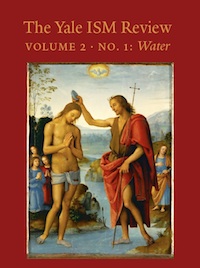Anne Rowthorn
Water is humanity’s cradle; it was our first home deep in our mothers’ wombs. Water is all things to all of life; it is as close to us as the tear in our eye and as distant as the cloud hovering over the open sea. As the Tao reminds us, “Water benefits ten thousand things,” though today we surely would not stop at ten thousand.
John Muir, the great Scottish-born naturalist and founder of the Sierra Club, America’s most ardent defender of the wilderness, cautioned against valuing one essential natural element apart from the others. In the account of his thousand-mile walk from his home in Wisconsin to the Gulf of Mexico, he said, “There is not a fragment in all nature, for every relative fragment of one thing is a full harmonious unit in itself. All together form one grand palimpsest of the world.”[1] Later, he observed during his first summer in the Sierra that, “When we try to pick out anything by itself we find it hitched to everything else in the universe.”[2] Still, water in all its forms, was picked out by John Muir and it was to occupy him for most of his life.
Water was in his view from his earliest boyhood days on the North Sea coast of Dunbar, Scotland where he scoured the shore for crabs and shells, bringing home his treasures from the sea. When he was eleven years old, he and his father and two siblings were the family advance party seeking new opportunity in the New World. By sailing ship to New York, and then canal boats through the Great Lakes and finally by wagon, the Muirs arrived in Wisconsin and built their first home in America. It was a small cabin on a kettle pond named Fountain Lake, close to Portage. It was an attractive location overlooking the pond. Young John Muir and his siblings fished and swam in it, but the future naturalist paid about as much attention to water as he did to sleeping and breathing.
It took John Muir’s first summer in Yosemite for him to comprehend the full significance of water and especially frozen water in the form of glaciers. “In October, 1871 . . . I discovered the Black Mountain Glacier in a shadowy amphitheater between Black and Red Mountains, two of the peaks of the Merced group.”[3] Thus began Muir’s quest to learn all he could about these unique, colossal, moving masses of ice. A series of glaciations modified the region starting about two to three million years ago and ending sometime around 10,000 years ago. Glacial systems reached depths of up to 4,000 feet, and their slowly moving floes of ice sculpted the Yosemite Valley. The retreating glaciers left fertile moraines, glacial boulders, and magnificent upland lakes and ponds. The longest glacier in the Yosemite area ran down the Grand Canyon of the Tuolumne River for sixty miles. The Merced Glacier flowed out of Yosemite Valley into the Merced River Gorge. Only Yosemite’s highest peaks were not covered by glaciers.
Glaciers are the indelible markers of the ages, and the eons of geological time never ceased to stir John Muir’s imagination. He said in his first published newspaper article in 1871, “There is a sublimity in the life of a glacier. Water rivers work openly, and so the rains and the gentle dews, and the great sea also grasping all the world; and even the universal ocean of breath, though invisible, yet speaks aloud in a thousand voices, and proclaims its modes of working and its power. But glaciers work apart from men, exerting their tremendous energies in silence and darkness, outspread, spirit-like, brooding above predestined rocks unknown to light, unborn, working on unwearied through unmeasured times, unhalting as the stars, until at length, their creations complete, their mountains brought forth, homes made for the meadows and the lakes, and fields for waiting forests, calm as when they came as crystals from the sky, they depart.”[4]
Yosemite’s lush valleys, moraines, waterfalls, verdant upland pastures were all sculptured by glaciers. Muir was so captivated by the effects of glacial action in Yosemite and how they fashioned the terrain that his sense of curiosity stoked his desire to seek what he described as “living glaciers,” glaciers that were still carving Earth’s landscape. Alaska would be the location where the action of living glaciers could be best observed. In his seven trips to the Land of the Midnight Sun, Muir never ceased to be energized by Alaska’s pristine land and seascapes—fresh air, tall trees, rushing rivers and waterfalls, abundant wildlife, and especially the glaciated landscape. Having spent the day canoeing between the head of the Wrangell Narrows and Cape Fanshaw, he recorded in his journal, “[One] learns that the world, though made, is being made; that this is still the morning of creation, that mountains and valleys long since conceived and now being born, channels traced for rivers, basins hollowed for lakes; that moraine soil is being ground and outspread for coming grasses . . . building particle on particle, cementing and crystallizing to make mountains, and valleys and plains . . . which like fluent pulsing water, rise in endless rhythm and beauty,”[5]
Water in all its forms not only shaped the landscape of the world, it was to engrave the naturalist’s inner landscape and impart a sense of well-being. Muir continuously wanted to be beside water or in it or on it. He had to taste it, feel it, hear it, smell its freshness. He camped by still lakes and the racing streams in Yosemite. He climbed trees in downpours to get the feel of water and wind against his body. He traversed rocky ledges to waterfalls where he silently sat while the mist soaked him through to the skin. Water to John Muir was life-force, source of inspiration, wonder, solace and beauty.
While John Muir might have wished to remain in a state of wonder and profound praise for water, his love for it and for all that was natural and wild catapulted him into the politics of water in the legendary Hetch Hetchy controversy. In 1906, the State of California ceded the Yosemite Valley and the Mariposa Grove to become Yosemite National Park. No sooner were papers signed establishing the park when the great San Francisco earthquake and fire occurred, fueling the city’s long-time desire to dam the Hetch Hetchy Valley in Yosemite for a new water supply. Muir, with the backing of the Sierra Club, presented strong opposition to the project. In 1908 he wrote to President Theodore Roosevelt, “There is not in all the wonderful Sierra, or indeed in the world, another so grand and wonderful a block in Nature’s handiwork[6] . . . These sacred mountain temples are the holiest ground that the heart of man has consecrated, and behooves us all faithfully to do our part in seeing that these wild mountain parks are passed on unspoiled to those who come after us.”[7] Muir and others believed that the sources for the city’s water were sufficient and that to flood and dam the breathtakingly beautiful Hetch Hetchy Valley, said to be lovelier than the Yosemite Valley, would be a travesty.
Unfortunately the odds were against him. Roosevelt left office in 1909 and the powerful Chief United States Forester, Gifford Pinchot, along with the City Supervisors of the City of San Francisco, held sway. Muir said, “Their arguments are curiously like those of the devil . . . These temple destroyers, devotees of raging commercialism, seem to have a perfect contempt for Nature, and, instead of lifting their eyes to the God of the mountains, lift them to the Almighty Dollar. Dam Hetch Hetchy!”[8] In December 1913 the United States Senate passed the enabling bill granting San Francisco full rights to Hetch Hetchy, even though it lay within the National Park. Some said that the loss of this pristine river valley broke John Muir’s heart. He died one year later on Christmas Eve.
Like John Muir, we all live in water worlds. The water that courses through our bodies is the water that upholds and nourishes all that is created, every animal of the land, fish of the sea, bird of the air; every flower, every fern and great towering sequoia. Water created the mountains, plains and valleys of the earth; water is yet creating, never ceasing. Water refreshes the soul and feeds the imagination. Water is life. We need to defend and protect it with our lives. Just as John Muir did. Water. “It is blessed thing to go free in this world, to see God playing upon everything . . . His fingers upon the lightening and torrent, on every wave of sea and sky, and every living thing, making all together sing and shine in sweet accord, the one love-harmony of the Universe.”[9]
 Anne Rowthorn, like many mothers and grandmothers of her generation, has worked in a number of venues—teacher at all levels from high school to graduate school, community organizer, professional interviewer at Yale, special-projects writer for the Episcopal Church in the U.S.A. She has a master’s degree from Columbia University and a PhD degree from New York University. She has written or compiled twelve books, of late specializing in the area of religion and ecology. Her most recent book is The Wisdom of John Muir: 100+ Selections from the Letters, Journals and Essays of the Great Naturalist.
Anne Rowthorn, like many mothers and grandmothers of her generation, has worked in a number of venues—teacher at all levels from high school to graduate school, community organizer, professional interviewer at Yale, special-projects writer for the Episcopal Church in the U.S.A. She has a master’s degree from Columbia University and a PhD degree from New York University. She has written or compiled twelve books, of late specializing in the area of religion and ecology. Her most recent book is The Wisdom of John Muir: 100+ Selections from the Letters, Journals and Essays of the Great Naturalist.
FOOTNOTES
[1] John Muir, A Thousand-Mile Walk to the Gulf (Boston: Houghton Mifflin Company, 1966), 164.
[2] John Muir, My First Summer in the Sierra (San Francisco: Sierra Club Books, 1988), 110. Original publication, 1911, by Houghton Mifflin.
[3] John Muir, The Mountains of California (Boston: Houghton Mifflin, 1894), Chapter 2. Courtesy of the Sierra Club. http://vault.sierraclub.org/john_muir_exhibit/writings/the_mountains_of_california/, accessed August 28, 2015.
[4] John Muir, “Yosemite Glaciers,” New York Tribune, December 5, 1871.
[5] John Muir, Journal entry for July 10, 1879, from Picturesque California and the Region West of the Rocky Mountains, from Alaska to Mexico (J. Dewling Publishing Co., 1888). Courtesy of the Sierra Club. http://vault.sierraclub.org/john_muir_exhibit/writings/picturesque_california/, accessed August 19, 2015.
[6] Note: Capitalization and punctuation throughout this article are from the original Muir texts.
[7] John Muir, Letter to Theodore Roosevelt [July 21, 1908], in William Frederic Badè, The Life and Letters of John Muir (Boston: Houghton Mifflin Co., 1924), vol. 2, Chapter 18.
[8] John Muir, The Yosemite, 1912, Chapter 16. Courtesy of the Sierra Club, http://vault.sierraclub.org/john_muir_exhibit/writings/the_yosemite/chapter_16.aspx, accessed August 24, 2015.
[9] John Muir, Letter to Janet Douglass Moores, February, 23, 1887, in The Life and Letters of John Muir, Vol. II, Ed. William Frederic Badè (Boston: Houghton Mifflin Company, 1924), Chapter 15. http://vault.sierraclub.org/john_muir_exhibit/life/life_and_letters/chapter_15.aspx, accessed August 28, 2015.
